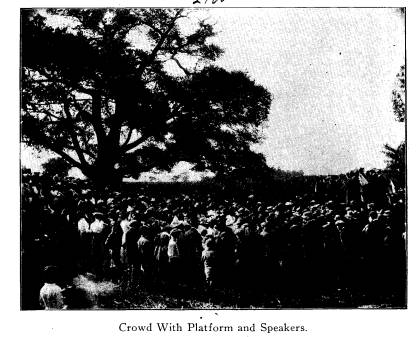Ohio History Journal
|
286 Ohio Arch. and Hist. Society Publications. The program began at 2 o'clock. Hon. E. O. Randall pre- sided, and after a very brief preliminary address introduced Mrs. Jones, who read the following paper: PRESENTATION SPEECH OF MRS. HOWARD JONES. One hundred and thirty-eight years ago this October, mo- mentous events were happening in this beautiful valley of the |
|
|
|
Scioto and history was being made in this fertile Pickaway plain-land. East of us about seven miles, at Camp Charlotte, were about fifteen hundred men under the command of Lord Dunmore, the English governor of Virginia; while near where we stand was the victorious but angered army, of about equal number, of Gen- eral Andrew Lewis. General Lewis' army represented the southern division of Lord Dunmore's recruits, which he had organized to exterminate |
Dedication of the Logan Elm. 287
the Indian tribes in the Ohio country.
It was flushed with the
victory over the great Chief Cornstalk
which was dearly earned
at Point Pleasant. Lord Dunmore had
promised to meet General
Lewis at Point Pleasant, but, changing
his mind, he had taken a
short cut across the country for the
Scioto river. Before he
had reached the Pickaway plains,
however, he was halted by
overtures of peace from the Indians.
Probably ignorant of the
defeat of Cornstalk, he encamped on the
high ground at the
present site of Leistville and named the
camp Charlotte. Here
he began arrangements for a treaty of
peace with the Red-men.
General Lewis, after his victory at
Point Pleasant, did not
wait long for his superior, Lord
Dunmore, but, crossing the
Ohio river, he made for the Indian
settlements in the Pickaway
Plains. Upon learning of the advance of
General Lewis, Lord
Dunmore sent a messenger with orders for
him to return with
his army to the mouth of the Kanawha
river. This Lewis re-
fused to do, and continued his advance
up the valley, to about
where we are now standing, and went into
camp.
Lord Dunmore was sorely tried. He was
negotiating peace
with the very Indians General Lewis had
just whipped with
great sacrifice, and this much desired
peace could not be obtained
unless General Lewis obeyed his order
and the influential Chief
Logan, who was sullen and non-committal
at his home at Old
Chillicothe, now Westfall, about five miles
to the north-west of
here, would lend his presence at the
council. Accordingly Lord
Dunmore himself came here, to General
Lewis' camp, to compel
him to return to the Kanawha river and
there await his coming.
While this act was being played by Lord
Dunmore and Gen-
eral Lewis, John Gibson, who had either
been sent by Lord Dun-
more for Logan, or who had volunteered
to go after Simon Girty
had failed to have Logan attend the
council, was returning from
Old Chillicothe with Logan's message to
the white-men, and,
here under this great elm, tradition
says, it was read by Gibson
to Lord Dunmore. John Gibson later, in a
sworn statement,
said that he took down the speech as it
was made to him by
Logan, while sitting in a thicket near
by where he had just been
talking with Cornstalk and other noted
chiefs of the Shawnees.
Thus was born the epic which fascinated
the scholarly Jef-
288 Ohio Arch. and Hist. Society
Publications.
ferson to the degree
that he declared it compared favorably with
any speech of
Demosthenes or Cicero. It matters little if this is
not the exact spot
where Lord Dunmore received the oration.
It could not have been
far from here. But, tradition, coming
down through several
reliable families whose representatives still
live near here, says
this magnificent old elm, the largest in all the
land, which then and
for many years after had a fine spring flow-
ing from its roots, is
the very same elm under whose branches,
spreading then as now,
the message was delivered. It was then,
is now and ever will be, a great message. It
has been
translated into many languages, and is known by every
school-boy and
school-girl throughout the land. It is a message
filled with fervor,
kindness and love, yet, it bristles with right-
eous anger and fearless
revenge. It is filled with pathos and
philosophy, and ends in
a sentence which is masterful in depict-
ing the extreme sorrow
of a great mind.
It is then fitting that
these acres of land and this old elm
which were silent
observers of the epoch making event which
brought peace to the
Indians and opened this fruitful country to
the new civilization,
should be preserved to posterity. Such land-
marks are lost all too
soon and are too little treasured.
Mr. Chairman, Pickaway
County, Ohio, is proud of being in-
strumental in
preserving this historic place, and with confidence
that the State of Ohio,
through her Archaeological Society will
preserve it, I hand you
the deed on behalf of our County Society.
In another few hundred
years this tree may be forever lost, but
the site shall remain,
and, let us hope that posterity may suitably
commemorate with a
monument of bronze the world famed
speech of the great
Mingo Chief, Logan.
Dr. G. Frederick
Wright, President of the Ohio Archaeo-
logical and Historical
Society, received the deed from the hands
of Mrs. Jones, and made
a brief but fitting speech of acceptance.
One of the
distinguished Indians present, Mr. Charles E.
Dagenett, of the Peoria
tribe, was then introduced and spoke
as follows:
ADDRESS OF CHARLES E.
DAGENETT.
In the early days of
Pennsylvania, the country around the
falls of the
Susquehannah was assigned by the Six Nations as
